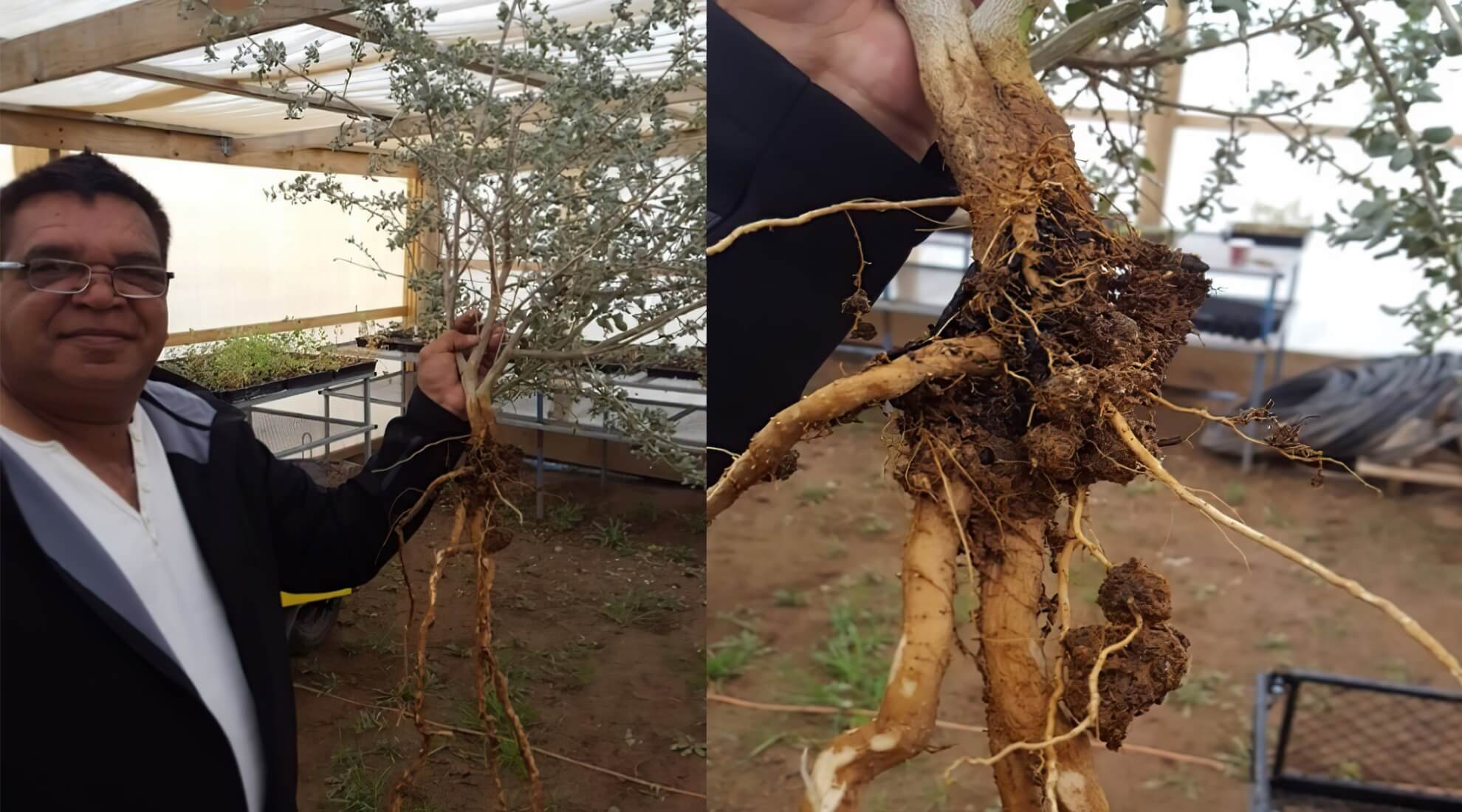BUNYURU
CONDUCTED ON THE EDGE OF SOUTH AUSTRALIA’S NULLArBOR PLAIN
Our first project is the Bunyuru Project, an initiative of the Tjilkaba/Scotdesco Aboriginal Community in partnership with Burra Asset Management which addresses the global problem of climate change by planting marginal, under-productive land with drought and salt resistant species capable of increasing the carbon content of the soil.
The Bunyuru project is conducted at the hamlet of Bookabie, a 10,000 Ha property owned by the community, about 130 kilometres west of the township of Ceduna, SA within the Eyre Peninsular on the edge of Australia’s famous Nullarbor Plain.
The core species is Atriplex (saltbush) a native Halophyte that grows naturally across most parts of Australia, recovering quickly from bushfire and flash floods without competing against fertile pasture supporting the global food chain. The rapid and long root growth of Atriplex (saltbush) species is well suited to carbon capture in the soil where mostly below grounds root matter is at least equivalent to that of above ground foliage.

Tjilkaba/Scotdesco CEO Robert Larking demonstrates the rapid and long root growth of Atriplex (saltbush) species necessary for carbon capture in the soil at the Aboriginal Community Project, Bookabie, South Australia
These crops are drought and salt resistant and withstand harsh and demanding climatic and soil conditions. Their ability to photosynthesize draws carbon from the atmosphere into the soil for long-term capture and storage. This process is measurable and accredited annually on an incremental basis as new stands are included in soil carbon programs.
This project creates about 120 permanent, new jobs for the Tjilkaba Aboriginal Community in Scotdesco, managed by the CEO Mr. Robert Larking and community elders. Additional positive outcomes include protein and nutrient rich cash crops for fodder and livestock pellets and additives for food, medicines and wellness products. Downstream values result in a better life on the land by uniquely addressing Environment, Social and Governance values known as ESG.
The Bunyuru Positives
Bunyuru is more than a host of sustainability benefits and nutrient
and protein rich fodders and carbon positive food, as it:
- Improves farming and increased productivity and land values for depleted farms from restoring the natural capital of marginal and degraded land;
- Delivers a raft of consequential new and permanent jobs for First Nations and rural Australians in remote areas where opportunity is limited;
- Promotes species that slow the progress of bush-fire and flood – recovering quickly from both while protecting oceans, rivers, and streams from effluent runoff;
- Reduces and reverses desertification;
- Reduces topsoil loss for improved grazing;
- Improve cash crops for carbon positive fodders;
- Feed pellets and antioxidants;
- Promotes carbon positive, renewable and dispatchable energy and fuel from biomass that dispenses with the need for expensive energy storage and does not compete with fertile landscape sustaining the global food chain.
The Bunyuru project (bunyuru means saltbush in the local Indigenous dialect) is the yardstick for adoption of the GTE program by other rural and aboriginal communities of Australia and the world as a model for self-empowerment and adoption to address climate change and benefit from ESG action for a better life from the land.
Above: Tjilkaba/Scotdesco community members prepare seedlings
Left: Hykos seedling production at Tjilkaba/Scotdesco
The Greening the Earth partnership for the remediation of land owned by the Tjilkaba/Scotdesco Aboriginal Community is a vision for the future health and prosperity for the future wellbeing of our country and our people.
The Bunyuru project is the yardstick for adoption by other rural and aboriginal communities of Australia and the world as a model for self-empowerment and adoption to address climate change and benefit from ESG action for a better life from the land.
Such may comprise GTE participants on many levels – project participants; their customers,; supporters and sponsors – all of whom are connected to and endorse GTE to catalyse the GTE maxim to deliver a better world from a better life on the land.
“The Greening the Earth partnership for the remediation of land owned by the Tjilkaba/Scotdesco Aboriginal Community is a vision for the future health and prosperity for the future wellbeing of our country and our people.
It draws from spiritual, physical, social and cultural connections and the natural affinity and knowledge that Aboriginal Australians have of the land going back some 60,000 years, as the World’s oldest living culture.
The cropping and manufacturing programs foster new employment, business, mentoring, and training opportunities for Scotdesco and the regional community, which, over time, will deliver improved skills and the profitable returns and economic self-sufficiency in a manner that is dignified and respectful of Aboriginal history, culture, and traditions.”
Tjilkaba/Scotdesco CEO Robert Larking demonstrates the rapid and long root growth of Atriplex (saltbush) species necessary for carbon capture in the soil at the Aboriginal Community Project, Bookabie, South Australia
The key is broadscale dispatchable, renewable, nett negative CO2 emissions energy – produced from widespread growth of vegetative biomass irrigated with salt water (referred to in this document as “carbon positive energy”) on land that otherwise, remains under-productive..
The saline irrigation process on such land does not compete with fertile pasture needed to support the global food chain, producing crops that drawdown, capture and store atmospheric GHG emissions in the soils of the earth, measured and monetized as globally accredited carbon offsets (”carbon credits”).
Saltbush hedge and NyPa Forage crops (growing on salt flats). Australian trials.
The Gayathi A. halimus plot West UAE (salt irrigated) ready for harvesting in less than two years
A haystack comprised of NyPa Forage
Above: A halimus trial (France)
Left: Landscape remediation applying waste effluent as fertilizing agent, Wickepin, WA
Sarcocornia growing on tidal flats
Commercial Salicornia cultivation (Belgium)
